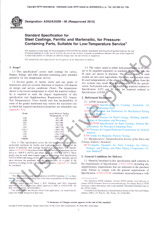We need your consent to use the individual data so that you can see information about your interests, among other things. Click "OK" to give your consent.
ASTM D8285/D8285M-19
Standard Practice for Compressive Properties of Tapered and Stepped Joints of Polymer Matrix Composite Laminates by Sandwich Construction Long Beam Flexure
Translate name
STANDARD published on 1.9.2019
The information about the standard:
Designation standards: ASTM D8285/D8285M-19
Publication date standards: 1.9.2019
SKU: NS-973110
The number of pages: 9
Approximate weight : 27 g (0.06 lbs)
Country: American technical standard
Category: Technical standards ASTM
Annotation of standard text ASTM D8285/D8285M-19 :
Keywords:
adhesives, composite materials, compression testing, core, joint properties, joint ultimate compressive strength, joint ultimate running loads, repair, stepped joints, tapered joints,
Additional information
| Significance and Use |
|
5.1 Flexure tests on flat sandwich panel construction may be conducted to determine facesheet scarf or step joint compressive strength. 5.2 This practice is limited to obtaining the compressive strength of the sandwich panel scarf and step joint facesheets. Due to the curvature of the flexural test specimen when loaded, facesheet compression strength from this test may not be equivalent to the facesheet compression strength of sandwich structures subjected to pure edgewise (in-plane) compression. 5.3 Factors that influence the compressive response and should therefore be reported include the following: materials (laminate facesheet, core, and adhesive); methods of material fabrication; methods of material preparation, including surface preparation prior to bonding, lay-up, specimen facesheet stacking sequence, and overall thickness; core geometry (cell size); core density; adhesive thickness; joint taper ratio or step length; ply overlap length; relative thickness and stiffness of parent and repair laminates; adhesive bond stiffness; specimen preparation; specimen conditioning; environment of testing; specimen alignment; speed of testing; time at temperature; void content; and volume percent reinforcement. Properties, in the test direction, which may be obtained from this practice, include the following: 5.3.1 Ultimate compressive strength (based on the nominal repair material thickness), (Frcu). 5.3.2 Ultimate running load per ply, (Note 2: Concentrated forces on beams with thin facesheets and low density cores can produce results that are difficult to interpret, especially close to the failure point. Wider loading blocks and rubber pads may assist in distributing the forces. Note 3: To ensure that simple sandwich beam theory is valid, a
good rule of thumb for the four-point bending test is the support
span length divided by the sandwich thickness should be greater
than 20 (1.1 This practice covers the procedure
for determination of the compressive strength of a tapered or
stepped bonded joint of polymer matrix composite materials. It is
applicable to secondary bonded or co-bonded laminates with either
unidirectional plies or woven fabric reinforcements. The materials
to be bonded may be different systems. In the bondline, a separate
adhesive material may or may not be used (example: adhesives may be
used with a prepreg system or may not be used with a wet lay-up
repair system). The range of acceptable test laminates and
thicknesses are described in 8.2.7. The standard repair types are the
same as for the tensile loading in Practice D8131/D8131M. While external patch
repairs are not explicitly covered in this practice, these repairs
could be tested as a non-standard specimen using this practice.
1.2 This practice supplements Test Method D7249/D7249M for compressive loading of facesheet sandwich constructions by long beam flexure. Several important test specimen parameters (for example, joint length, ply overlaps, step depth, and taper ratio) are not mandated by this practice; however, these parameters are required to be specified and reported to support repeatable results. 1.3 Unidirectional (0° ply orientation) composites as well as multi-directional composite laminates and fabric composites, can be tested. 1.4 Units—The values stated in either SI units or inch-pound units are to be regarded separately as standard. The values stated in each system are not necessarily exact equivalents; therefore, to ensure conformance with the standard, each system shall be used independently of the other, and values from the two systems shall not be combined. 1.4.1 Within the text, the inch-pound units are shown in brackets. 1.5 This standard does not purport to address all of the safety concerns, if any, associated with its use. It is the responsibility of the user of this standard to establish appropriate safety, health, and environmental practices and determine the applicability of regulatory limitations prior to use. 1.6 This international standard was developed in accordance with internationally recognized principles on standardization established in the Decision on Principles for the Development of International Standards, Guides and Recommendations issued by the World Trade Organization Technical Barriers to Trade (TBT) Committee. |
We recommend:
Technical standards updating
Do you want to make sure you use only the valid technical standards?
We can offer you a solution which will provide you a monthly overview concerning the updating of standards which you use.
Would you like to know more? Look at this page.




 Cookies
Cookies
